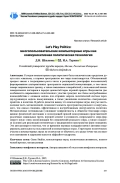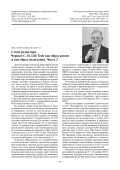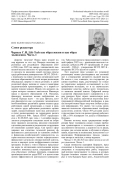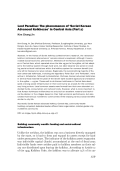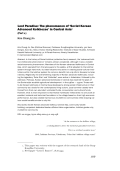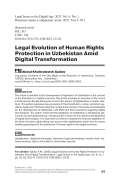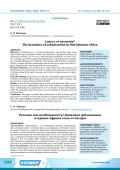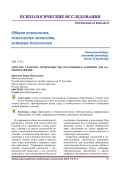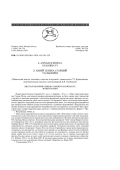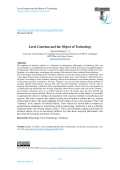Сегодня компьютерные игры перестают быть исключительно средством досуга или эскапизма, а игровое пространство все чаще политизируется. Обозначенный процесс связан с тенденциями роста числа и расширения демографии пользователей, формированием альтернативных пространств социальной коммуникации, в том числе поверх национальных границ, а также появлением и выработкой у пользователей новых поведенческих паттернов и передач ценностей через игровой процесс. Выделяются две особенности современного политического участия граждан: все более востребованное взаимодействие с «новыми медиа» для отправки запроса политической системе через двухуровневую модель коммуникации, а также увеличение количества «театральных практик» в политике. В работе делается вывод, что компьютерные игры, как уже неотъемлемая часть метавселенной, позволяют множить пространства реального и виртуального, тем самым становясь эффективным и востребованным инструментом политики. Метавселенные потенциально усиливают конфликтность в обществе благодаря сокращению физической дистанции и последующей прямой коммуникации представителей различных социальных групп, игровой элемент и условность «нереального» мира формирует иную этику коммуникации без ограничений реального мира, а также создаются условия для реализации нетипичных в традиционном пространстве форм поведения. Это актуализирует гипотезу, что со временем игровые площадки начнут активнее модерировать деятельность пользователей в компьютерных играх. Структурно политическое участие в компьютерных играх не отличается от обычного, его целью точно так же является завоевание и удержание власти в оффлайн-государстве.
Слово редактора к выпуску журнала Том 15, № 3
Вступительное слово редактора к выпуску Том 15, № 2
In the history of Soviet kolkhoz (collective-farm) research, the ‘advanced kolkhoz (millionaire) phenomenon’ remains almost unexplored, although it was a notable social-economic phenomenon. Members of the Korean advanced kolkhozes in Central Asia, which operated since the late 1930s to the 1980s, at first adapted to the kolkhoz system through hard work, but later became very active in creating social-cultural institutions within the kolkhoz system for common benefit (not only ethnic Koreans but also natives). Regionally, the overwhelming majority of Korean advanced kolkhozes, including the legendary ‘Polar Star’ and ‘Politotdel’, were active in Uzbekistan, followed by Kazakhstan. Perhaps, Korean advanced kolkhozes in Central Asia reached the peak of the Soviet-style socialist agricultural civilization in the 1960s - 1970s. These well-to-do Korean kolkhozes in Central Asia developed a strong social infrastructure in their community as a basis for the contemporary living culture. Local common assets were formed from their own abundant undivided funds, consumption and cultural funds. However, what is more important is that Korean kolkhozes-millionaires not only built an excellent material and technical foundation in the villages based on their high economic performance, but also created harmonious multiethnic communities while enjoying various social benefits similar to city life.
In the history of Soviet kolkhoz (collective-farm) research, the ‘advanced kolkhoz (millionaire) phenomenon’ remains almost unexplored, although it was a notable social-economic phenomenon. Members of the Korean advanced kolkhozes in Central Asia, which operated from the late 1930s to the 1980s, at first adapted to the kolkhoz system through hard work, but later became very active in creating social-cultural institutions within the kolkhoz system for common benefit (not only ethnic Koreans but also natives). Regionally, the overwhelming majority of Korean advanced kolkhozes, including the legendary ‘Polar Star’ and ‘Politotdel’, were active in Uzbekistan, followed by Kazakhstan. Perhaps, Korean advanced kolkhozes in Central Asia reached the peak of the Soviet-style socialist agricultural development in the 1960s - 1970s. These wellto-do Korean kolkhozes in Central Asia developed a strong social infrastructure in their community as a basis for the contemporary living culture. Local common assets were formed from their own abundant undivided funds, consumption and cultural funds. However, what is more important is that Korean kolkhozes-millionaires not only built an excellent material and technical foundation in the village based on their high economic performance, but also created harmonious multiethnic communities while enjoying various social benefits similar to city life.
This study focuses on the development of an algorithm for constructing the vocabulary of a Syrian dialectal multimedia dictionary. The significance of this research stems from the inadequate representation of Syrian dialectal lexicon in existing lexicographical resources. The novelty lies in the creation of a universal model for an Arabic dialectal multimedia dictionary, using the Syrian dialect as a foundation, and in proposing a methodology for utilising film texts as a source of Arabic dialectal vocabulary, followed by the processing of this lexical material. The initial sample of dialectal lexical items comprised 100 words and was subsequently expanded to 1,500. The proposed multimedia dictionary project caters to the needs of diverse user categories by providing, for example, etymological, phonetic, grammatical, and semantic information about each lexical unit, visualisation of its concept, and supplementary semantisation through film discourse fragments. Encompassing both original Arabic words and borrowings from languages such as Syriac, Turkish, French, and English, the dictionary aims to reflect the lexical composition of the Syrian dialect and is geared towards enhancing the systematisation and lexicography of Arabic dialects in general. This endeavour makes a substantial contribution to the fields of linguistics and lexicography, while also promoting the preservation and study of Arabic dialects.
The article is devoted to the development of legislation of Uzbekistan in the context of the transition to a digital economy. The article provides an overview of the norms introduced into the law taking into account the impact of digitalization on public relations. The author examines new provisions of the Constitution, codes, and other regulatory legal acts. Particular attention is paid to the review of concepts and strategies for the development of Uzbekistan until 2030 and their provisions regarding digital technologies. The author notes that the legislation of Uzbekistan is developing taking into account global trends, including such a factor as the intensive development of digital technologies. It is important to continue measures to improve legislation in the field of human rights taking into account the digitalization factor and to ensure reliable guarantees for the protection of human rights in the digital economy.
The filtration process is studied for a popular class of filters with radial cartridges that proved their high effectiveness in purification of water. The mass balance equation for radial flows in porous media is obtained by using the lattice approximation method, the transverse diffusion process being taken into account. The Euler dynamical equations are modified by including the Darcy force proportional to the velocity of the filtration flow. The system of equations is written for the stationary axially symmetric radial flow and solved by the perturbation method, if the vertical velocity is supposed to be small.
Relevance. Urbanization is a crucial transformative process that plays a key role in achieving sustainable economic development in the global economy. An urbanized economy can serve as a vital structural mechanism to foster inclusive economic growth by generating employment, reducing income inequalities, and alleviating poverty. However, Sub-Saharan Africa (SSA) is characterized by a unique and slow urbanization process that sets it apart from other regions, despite steady economic growth in recent decades. Research Objective. This study aims to empirically assess the patterns and determinants of urbanization in SSA, focusing on the question of whether it is driven primarily by mere economic survival or by improvements in quality of life. Data and Methods. Based on Lee’s rural push-urban pull migration theory, the Common Correlated Effects Mean Group estimator was used to analyze data from 44 SSA countries between 1996 and 2022. Results. Access to basic amenities has a positive and significant impact on urbanization in Africa, although the effect was more modest for improved amenities. Additionally, the agricultural sector was found to hinder urbanization, while the manufacturing and services sectors promote it through structural transformation. Conclusion. The paper concludes that urbanization in SSA is driven by both the need for economic survival and the desire to improve quality of life. To enhance the region’s global competitiveness, it is crucial to invest in and develop critical infrastructure that supports the urbanization process.
Статья посвящена исследованию концепции образования в течение всей жизни (lifelong learning) как ответа на вызовы современного мира, включая технологический прогресс, трансформацию рынка труда и необходимость постоянного обновления знаний, навыков и умений.
Шестая свазория СЕНЕКИ СТАРШЕГО в контексте эпохи жанра
The emphasis on technical artifacts is a hallmark of contemporary philosophy of technology. How can Leroi-Gourhan’s conceptualization of the technical object enrich current discussions among philosophers of technology? This article aims not to exhaustively address this question but to briefly outline how LeroiGourhan, as an ethnologist, reconfigures the concept of the technical object inherited from ethnology. The article begins by presenting Leroi-Gourhan’s ambition to revisit the central question of ethnology: what is the origin of the division of the human mass into distinct ethnic units called “peoples”, distributed across the globe? According to Leroi-Gourhan, ethnology did not divide humanity at its natural junctures, leading to inaccurate historical conclusions. For him, “peoples” are not fixed and uniform entities defined by constant, specific characteristics. Instead, they arise from the temporary convergence of traits, such as language and technology, which have their own independent existence. These traits may come together at a certain point, but beyond that, they diverge. Ethnology should focus on these traits, not on the “peoples.” In particular, technology serves as a reliable indicator of how the human mass has been divided and dispersed across space and time. However, to draw solid conclusions on this matter, it is essential to approach the extensive technical documentation with a rigorous method of classification and analysis. The article examines this method, leading Leroi-Gourhan to redefine the very concept of the technical object. The article highlights Leroi-Gourhan’s focus on the concepts of “fact” and “tendency” in his analysis of technical objects. These objects are viewed both as solutions to general human challenges in transforming matter (representing “tendencies”) and as culturally significant items with varying “degrees of fact.” Thus, Leroi-Gourhan assigned a dual nature to technical objects, but in an interestingly different way than those analytical philosophers who have been discussing the dual nature of artefacts.
